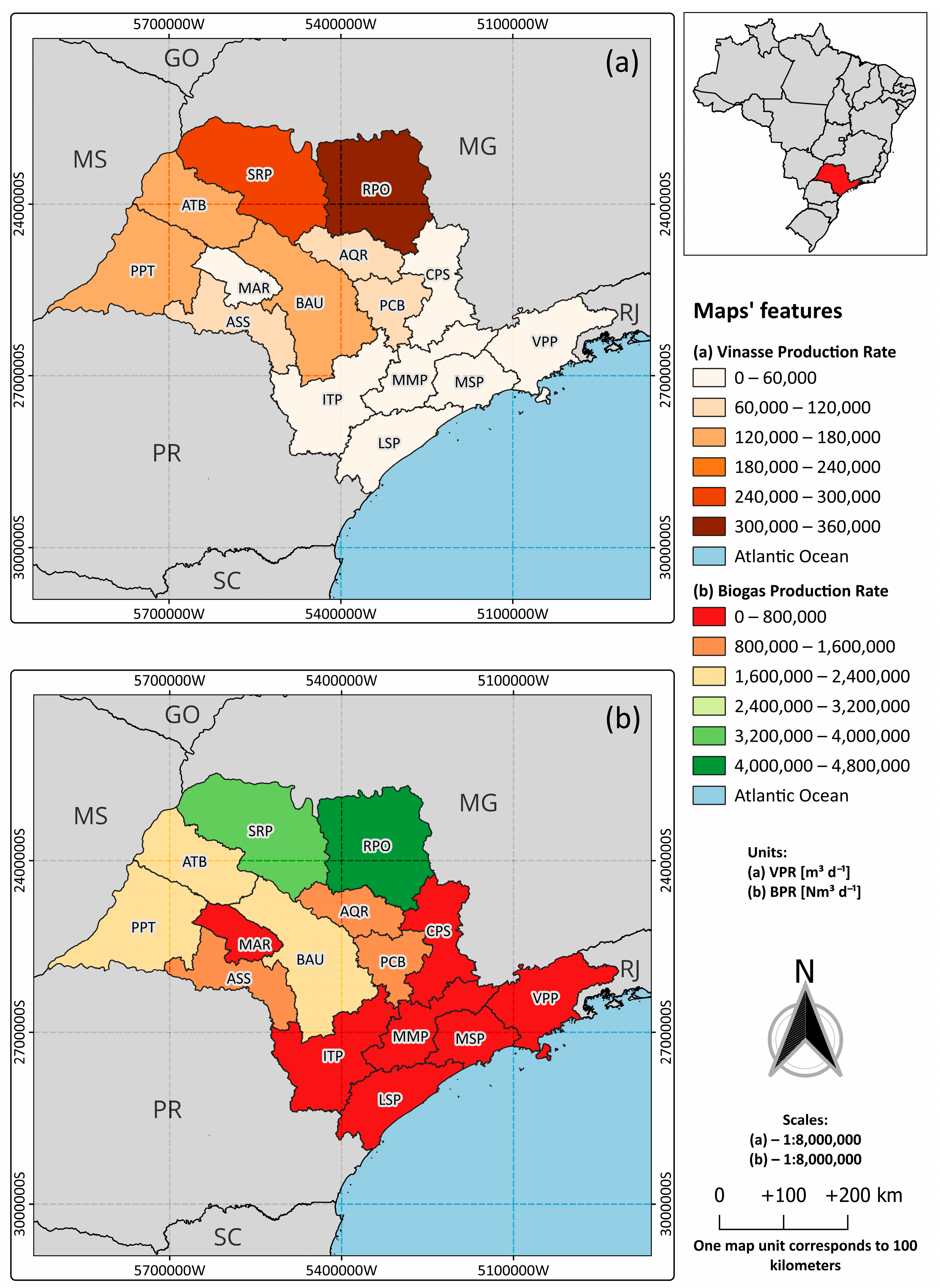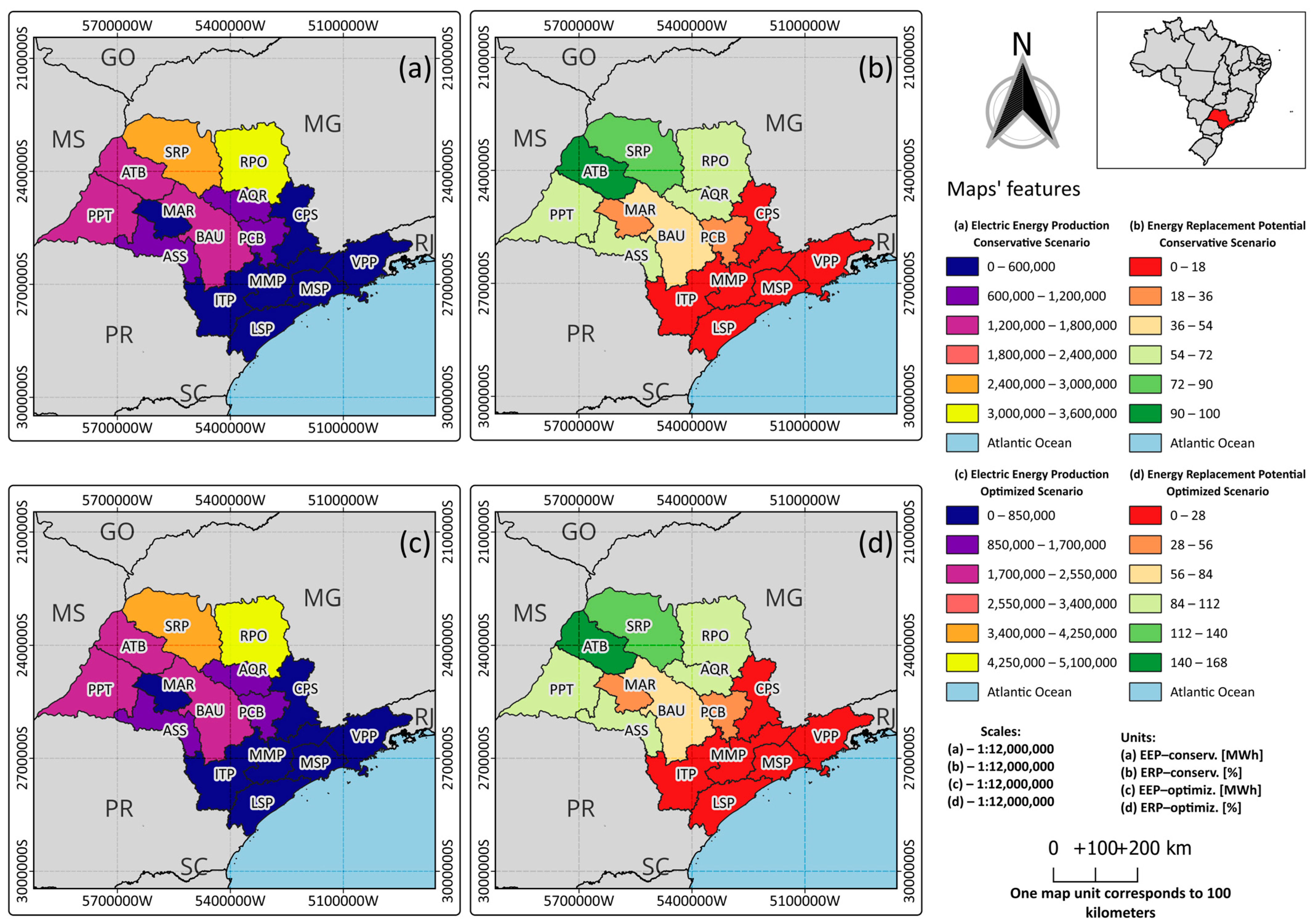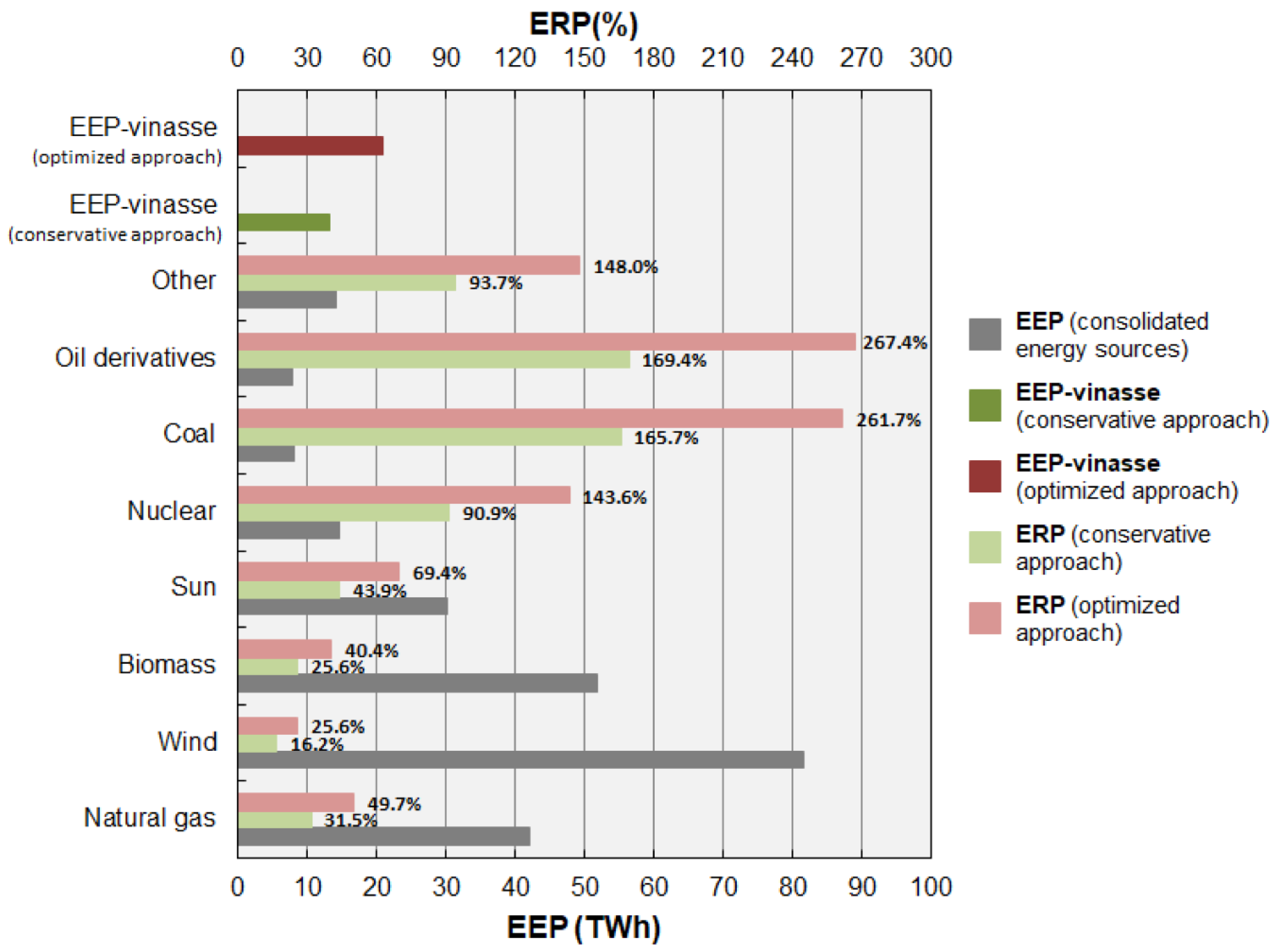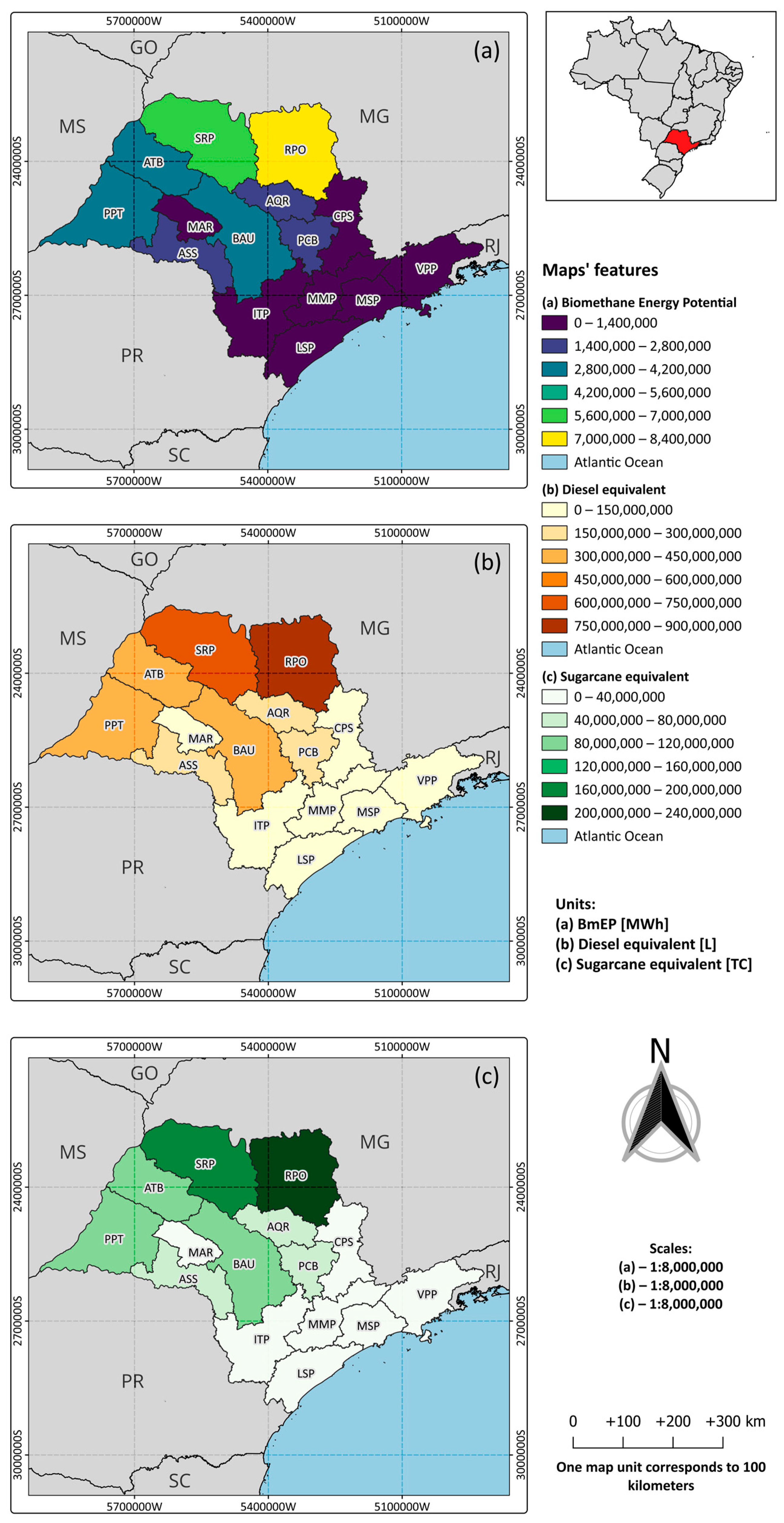Methane Production from Sugarcane Vinasse Biodigestion: An Efficient Bioenergy and Environmental Solution for the State of São Paulo, Brazil
Abstract
1. Introduction
2. Methods
2.1. Description of the State of São Paulo
2.2. Input Data for Calculations
2.3. Energy Assessment Methodology
2.3.1. Calculation Procedure
| Parameter (Symbol) | Value | Unit | Reference | |
|---|---|---|---|---|
| Sugarcane production and processing | Sugarcane productivity (SCP) | 81.529 | TC ha−1 | [4] |
| Ethanol yield a (EY) | 53.4 | Lethanol TC−1 | [18] | |
| Specific vinasse generation (SVG) | 13.0 | Lvinasse L−1ethanol | [30] | |
| Harvesting period (HP) | 240 | d | [27] | |
| Vinasse biodigestion | Chemical oxygen demand (COD) of vinasse a | 35.4 | g L−1 or kg m−3 | [30] |
| COD removal efficiency (ERCOD) b | 86.5 | % | [28] | |
| Methane yield (MY) b | 0.343 | Nm3CH4 kg−1CODremoved | [28] | |
| Methane concentration in biogas (CCH4,biogas) b | 81.2 | % | [28] | |
2.3.2. Comparative Analyses: Electricity Production
2.3.3. Comparative Analyses: bioCH4 Production
2.4. Environmental Assessment Methodology
2.5. Mapping of Key Results
3. Results and Discussion
3.1. Spatial Distribution of Vinasse-Derived Biogas in SP
3.2. Electric Potential of Vinasse-Derived Biogas
3.3. Biomethane Production from Sugarcane Vinasse
3.4. Assessment of GHG Emissions
4. Conclusions
Author Contributions
Funding
Institutional Review Board Statement
Informed Consent Statement
Data Availability Statement
Conflicts of Interest
References
- Moraes, B.S.; Zaiat, M.; Bonomi, A. Anaerobic digestion of vinasse from sugarcane ethanol production in Brazil: Challenges and perspectives. Renew. Sustain. Energy Rev. 2015, 44, 888–903. [Google Scholar] [CrossRef]
- Rossi, L.M.; Gallo, J.M.R.; Mattoso, L.H.C.; Buckeridge, M.S.; Licence, P.; Allen, D.T. Ethanol from Sugarcane and the Brazilian Biomass-Based Energy and Chemicals Sector. ACS Sustain. Chem. Eng. 2021, 9, 4293–4295. [Google Scholar] [CrossRef]
- U.S. Department of Energy. Alternative Fuels Data Center: Global Ethanol Production by Country or Region. Available online: https://afdc.energy.gov/data/10331 (accessed on 17 September 2023).
- Companhia Nacional de Abastecimento. Acompanhamento da Safra Brasileira de Cana-de-açúcar, v. 11, n. 2. Safra 2023/24: 2° Levantamento; Companhia Nacional de Abastecimento: Brasília, Brazil, 2023. Available online: https://www.conab.gov.br/component/k2/item/download/48807_c8687b85489cc7d6bb3b0495675b317a (accessed on 17 September 2023).
- Fundação Sistema Estadual de Análise de Dados. São Paulo Lidera Produção de Etanol no País. Available online: https://informa.seade.gov.br/wp-content/uploads/sites/8/2021/11/Seade-informa-economia-sao-paulo-lidera-producao-etanol-pais.pdf (accessed on 17 September 2023).
- Fuess, L.T.; Lens, P.N.L.; Garcia, M.L.; Zaiat, M. Exploring Potentials for Bioresource and Bioenergy Recovery from Vinasse, the “New” Protagonist in Brazilian Sugarcane Biorefineries. Biomass 2022, 2, 374–411. [Google Scholar] [CrossRef]
- Reis, C.E.R.; Hu, B. Vinasse from Sugarcane Ethanol Production: Better Treatment or Better Utilization? Front. Energy Res. 2017, 5, 7. [Google Scholar]
- Carvalho, J.C.; Vandenberghe, L.P.S.; Sydney, E.B.; Karp, S.G.; Magalhães, A.I., Jr.; Martinez-Burgosm, W.J.; Medeiros, A.B.P.; Thomaz-Soccol, V.; Vieira, S.; Letti, L.A.J.; et al. Biomethane Production from Sugarcane Vinasse in a Circular Economy: Developments and Innovations. Fermentation 2023, 9, 349. [Google Scholar] [CrossRef]
- Fuess, L.T.; Altoé, M.E.; Felipe, M.C.; Garcia, M.L. Pros and cons of fertirrigation with in natura sugarcane vinasse: Do improvements in soil fertility offset environmental and bioenergy losses? J. Clean. Prod. 2021, 319, 128684. [Google Scholar] [CrossRef]
- Christofoletti, C.A.; Escher, J.P.; Correia, J.E.; Marinho, J.F.U.; Fontanetti, C.S. Sugarcane vinasse: Environmental implications of its use. Waste Manag. 2013, 33, 2752–2761. [Google Scholar] [CrossRef] [PubMed]
- Fuess, L.T.; Garcia, M.L. Implications of stillage land disposal: A critical review on the impacts of fertigation. J. Environ. Manag. 2014, 145, 210–229. [Google Scholar] [CrossRef] [PubMed]
- Lourenço, K.S.; Rossetto, R.; Vitti, A.C.; Montezano, Z.F.; Soares, J.R.; Sousa, R.M.; Carmo, J.B.; Kuramae, E.E.; Cantarella, H. Strategies to mitigate the nitroux oxide emissions from nitrogen fertilizer applied with organic fertilizers in sugarcane. Sci. Total Environ. 2019, 650, 1476–2486. [Google Scholar] [CrossRef]
- Carmo, J.B.; Filoso, S.; Zotelli, L.C.; Sousa Neto, E.R.; Pitombo, L.M.; Duarte-Neto, P.J.; Vargas, V.P.; Andrade, C.A.; Gava, G.J.C.; Rossetto, R.; et al. Infield greenhouse gas emissions from sugarcane soil Brazil: Effects from synthetic and organic fertilizer application and crop trash accumulation. GCB Bioenergy 2013, 5, 267–280. [Google Scholar] [CrossRef]
- Oliveira, B.G.; Carvalho, J.L.N.; Cerri, C.E.P.; Cerri, C.C.; Feigl, B.J. Greenhouse gas emissions from sugarcane vinasse transportation by open channel: A case study in Brazil. J. Clean. Prod. 2015, 94, 102–107. [Google Scholar] [CrossRef]
- Oliveira, B.G.; Carvalho, J.L.N.; Chagas, M.F.; Cerri, C.E.P.; Cerri, C.C.; Feigl, B.J. Methane emissions from sugarcane vinasse storage and transportation systems: Comparison between open channels and tanks. Atmos. Environ. 2017, 159, 135–146. [Google Scholar] [CrossRef]
- Sebigas Cótica. Biogás de Vinhaça: Uma Realidade. Available online: https://www.sebigascotica.com.br/artigo/biogas-de-vinhaca-uma-realidade.html (accessed on 18 September 2023).
- Copersucar. Grupo Cocal Inicia Produção de Biogás em Narandiba (SP). Available online: https://www.copersucar.com.br/noticias/grupo-cocal-inicia-producao-pioneira-de-biogas-no-brasil/ (accessed on 18 September 2023).
- Moraes, B.S.; Junqueira, T.L.; Pavanello, L.G.; Cavalett, O.; Mantelatto, P.E.; Bonomi, A.; Zaiat, M. Anaerobic digestion of vinasse from sugarcane biorefineries in Brazil from energy, environmental, and economic perspectives: Profit or expense? Appl. Energy 2014, 113, 825–835. [Google Scholar] [CrossRef]
- Fuess, L.T.; Zaiat, M. Economics of anaerobic digestion for processing sugarcane vinasse: Applying sensitivity analysis to increase process profitability in diversified biogas applications. Process Saf. Environ. Prot. 2018, 115, 27–37. [Google Scholar] [CrossRef]
- Longati, A.A.; Lino, A.R.A.; Giordano, R.C.; Furlan, F.F.; Cruz, A.J.G. Biogas production from anaerobic digestion of vinasse in sugarcane biorefinery: A techno-economic and environmental analysis. Waste Biomass Valor. 2020, 11, 4573–4591. [Google Scholar] [CrossRef]
- Ramos, L.R.; Lovato, G.; Rodrigues, J.A.D.; Silva, E.L. Scale-up and energy estimations of single- and two-stage vinasse anaerobic digestion systems for hydrogen and methane production. J. Clean. Prod. 2022, 349, 131459. [Google Scholar] [CrossRef]
- Fuess, L.T.; Zaiat, M.; Lens, P.N.L. Technological strategies for managing sugarcane vinasse in two-stage biodigestion plants: Energetic and economic aspects. Energy Convers. Manag. 2023, 295, 117603. [Google Scholar] [CrossRef]
- Hu, J.; Harmsen, R.; Crijins-Graus, W. Developing a Method to Account for Avoided Grid Losses from Decentralized Generation: The EU Case. Energy Procedia 2017, 141, 604–610. [Google Scholar] [CrossRef]
- Secretaria de Meio Ambiente, Infraestrutura e Logística. PEE 2050—Plano Estadual de Energia. São Paulo, Brazil. Available online: https://semil.sp.gov.br/sem/pee-2050/#1696957587872-9e246642-f670 (accessed on 5 March 2024).
- Instituto Brasileiro de Geografia e Estatística. Censo 2022. Available online: https://www.ibge.gov.br/estatisticas/sociais/trabalho/22827-censo-demografico-2022.html (accessed on 18 September 2023).
- UNICAdata. Available online: https://unicadata.com.br/listagem.php?idMn=4 (accessed on 18 September 2023).
- Companhia Nacional de Abastecimento. Perfil do Setor do Açúcar e do Etanol no Brasil: Edição Para a Safra 2015/16. Companhia Nacional de Abastecimento: Brasília, Brazil, 2019. Available online: https://www.conab.gov.br/component/k2/item/download/26992_71d0aa6fb4ab68dfcdd8ef4e5b180138 (accessed on 28 September 2023).
- Fuess, L.T.; Braga, A.M.F.; Zaiat, M.; Lens, P.N.L. Solving the seasonality issue in sugarcane biorefineries: High-rate year-round methane production from fermented sulfate-free vinasse and molasses. Chem. Eng. J. 2023, 478, 147432. [Google Scholar] [CrossRef]
- Santos, P.S.; Zaiat, M.; Nascimento, C.A.O.; Fuess, L.T. Does sugarcane vinasse composition variability affect the bioenergy yield in anaerobic systems? A dual kinetic-energetic assessment. J. Clean. Prod. 2019, 240, 118005. [Google Scholar] [CrossRef]
- Heywood, J.B. Internal Combustion Engine Fundamentals, 1st ed.; McGraw-Hill: New York, NY, USA, 1988. [Google Scholar]
- Boyce, M.P. Combined cycle power plants. In Combined Cycle Systems for Near-Zero Emission Power Generation, 1st ed.; Rao, A.D., Ed.; Woodhead Publishing Limited: Cambridge, UK, 2012; pp. 1–43. [Google Scholar]
- Junqueira, T.L.; Moraes, B.; Gouveia, V.L.R.; Chagas, M.F.; Morais, E.R.; Watanabe, M.D.B.; Zaiat, M.; Bonomi, A. Use of VSB to plan research programs and public policies. In Virtual Biorefinery: An Optimization Strategy for Renewable Carbon Valorization, 1st ed.; Bonomi, A., Cavalett, O., Cunha, M.P., Lima, M.A.P., Eds.; Springer: London, UK, 2016; pp. 257–282. [Google Scholar]
- Volpi, M.P.C.; Fuess, L.T.; Moraes, B.S. Anaerobic co-digestion of residues in 1G2G sugarcane biorefineries for enhanced electricity and biomethane production. Bioresour. Technol. 2021, 330, 124999. [Google Scholar] [CrossRef]
- Agência Nacional do Petróleo, Gás Natural e Biocombustíveis. Resolução ANP Nº 906, de 18 de Novembro de 2022—DOU 221, de 24/11/2022. Available online: https://atosoficiais.com.br/anp/resolucao-n-906-2022-dispoe-sobre-as-especificacoes-do-biometano-oriundo-de-produtos-e-residuos-organicos-agrossilvopastoris-e-comerciais-destinado-ao-uso-veicular-e-as-instalacoes-residenciais-e-comerciais-a-ser-comercializado-em-todo-o-territorio-nacional?origin=instituicao (accessed on 29 September 2023).
- Muñoz, R.; Meier, L.; Diaz, I.; Jeison, D. A critical review on the state-of-the-art of physical/chemical and biological technologies for an integral biogas upgrading. Rev. Environ. Sci. Biotechnol. 2015, 14, 727–759. [Google Scholar] [CrossRef]
- Empresa de Pesquisa Energética. Anuário Estatístico de Energia Elétrica—Ano base 2022. Empresa de Pesquisa Energética: Rio de Janeiro, Brazil, 2023. Available online: https://www.epe.gov.br/sites-pt/publicacoes-dados-abertos/publicacoes/PublicacoesArquivos/publicacao-160/topico-168/anuario-factsheet.pdf (accessed on 1 October 2023).
- União da Indústria de Cana-de-Açúcar e Bioenergia. Bioeletricidade em Números: Ano de 2021. União da Indústria de Cana-de-Açúcar e Bioenergia: São Paulo, Brazil. Available online: https://unicadata.com.br/arquivos/pdfs/2022/02/09ac2744aba07610bd1041fb78592365.pdf (accessed on 1 October 2023).
- Silva Neto, J.V.; Gallo, W.L.R.; Nour, E.A.A. Production and use of biogas from vinasse: Implications for the energy balance and GHG emissions of sugar cane ethanol in the Brazilian context. Environ. Prog. Sustain. Energy 2020, 39, 13226. [Google Scholar] [CrossRef]
- Intergovernmental Panel on Climate Change. Climate Change: The Physical Science Basis; Contribution of Working Group I to the Fourth Assessment Report of the Intergovernmental Panel on Climate Change (IPCC); Cambridge University Press: Cambridge, UK, 2007. [Google Scholar]
- Joint Research Centre; Institute for Energy and Transport; Rose, K.; Nelson, R.; Hamje, H. Well-to-Wheels Analysis of future Automotive Fuels and Powertrains in the European Context: Tank-to-Wheels Report (TTW), Version 4a, April 2014; Rose, K., Nelson, R., Hamje, H., Godwin, S., Reid, A., Edwards, R., Lonza, L., Krasenbrink, A., Eds.; Publications Office of the European Union: Luxembourg; Available online: https://data.europa.eu/doi/10.2790/95839 (accessed on 15 October 2023).
- Instituto Brasileiro de Geografia e Estatística. Malha Municipal Digital da Divisão Político-Administrativa Brasileira. Available online: https://www.ibge.gov.br/geociencias/organizacao-do-territorio/malhas-territoriais/15774-malhas.html?=&t=sobre (accessed on 15 October 2023).
- Fuess, L.T.; Zaiat, M.; Nascimento, C.A.O. Can biogas-producing sugarcane biorefineries techno-economically outperform conventional ethanol production? Deciphering the way towards maximum profitability. Energy Convers. Manage. 2022, 254, 115206. [Google Scholar] [CrossRef]
- Albarracin, L.T.; Mas, I.R.; Fuess, L.T.; Rodriguez, R.P.; Volpi, M.P.C.; Moraes, B.S. The Bioenergetic Potential from Coffee Processing Residues: Towards an Industrial Symbiosis. Resources 2024, 13, 21. [Google Scholar] [CrossRef]
- Marconi, P.; Rosa, L. Role of biomethane to offset natural gas. Renew. Sustain. Energy Rev. 2023, 187, 113697. [Google Scholar] [CrossRef]
- Pääkkönen, A.; Aro, K.; Aalto, P.; Konttinen, J.; Kojo, M. The Potential of Biomethane in Replacing Fossil Fuels in Heavy Transport–A Case Study on Finland. Sustainability 2019, 11, 4750. [Google Scholar] [CrossRef]
- Secretaria de Meio Ambiente, Infraestrutura e Logística. Balanço Energético do Estado de São Paulo—2022: Ano Base 2021; Secretaria de Meio Ambiente, Infraestrutura e Logística: São Paulo, Brazil, 2022. Available online: https://dadosenergeticos.energia.sp.gov.br/portalcev2/intranet/BiblioVirtual/diversos/BalancoEnergetico.pdf (accessed on 8 March 2024).
- Secretaria de Meio Ambiente, Infraestrutura e Logística. Anuário de Energéticos por Município no Estado de São Paulo—2023: Ano Base 2022; Secretaria de Meio Ambiente, Infraestrutura e Logística: São Paulo, Brazil, 2023. Available online: https://dadosenergeticos.energia.sp.gov.br/portalcev2/intranet/BiblioVirtual/diversos/anuario_energetico_municipio.pdf (accessed on 8 March 2024).
- Ometto, A.R.; Hauschild, M.Z.; Roma, W.N.L. Lifecycle assessment of fuel ethanol from sugarcane in Brazil. Int. J. Life Cycle Assess. 2009, 14, 236–247. [Google Scholar] [CrossRef]
- Silva Neto, J.V.; Gallo, W.L.R. Potential impacts of vinasse biogas replacing fossil oil for power generation, natural gas, and increasing sugarcane energy in Brazil. Renew. Sustain. Energy Rev. 2021, 135, 110281. [Google Scholar] [CrossRef]
- Joppert, C.L.; Perecin, D.; Santos, M.M.; Coelho, S.T.; Camacho, J.L.P. A short-cut model for predicting biomethane availability after biogas upgrading. J. Clean. Prod. 2018, 200, 148–160. [Google Scholar] [CrossRef]
- Macedo, I.C.; Seabra, J.E.A.; Silva, J.E.A.R. Green house gases emissions in the production and use of ethanol from sugarcane in Brazil: The 2005/2006 averages and a prediction for 2020. Biomass Bioenergy 2008, 32, 582–595. [Google Scholar] [CrossRef]
- Vasconcelos, A.L.S.; Cherubin, M.R.; Cerri, C.E.P.; Feigl, B.J.; Reis, A.F.B.; Siqueira-Neto, M. Sugarcane residue and N-fertilization effects on soil GHG emissions in south-central, Brazil. Biomass Bioenergy 2022, 158, 106342. [Google Scholar] [CrossRef]
- Kabeyi, M.J.B.; Olanrewaju, O.A. Biogas Production and Applications in the Sustainable Energy Transition. J. Energy 2022, 2022, 8750221. [Google Scholar] [CrossRef]
- Formann, S.; Hahn, A.; Janke, L.; Stinner, W.; Sträuber, H.; Logroño, W.; Nikolausz, M. Beyond Sugar and Ethanol Production: Value Generation Opportunities Through Sugarcane Residues. Front. Energy Res. 2020, 8, 579577. [Google Scholar] [CrossRef]
- Ministério do Meio Ambiente. Programa Nacional Metano Zero; Ministério do Meio Ambiente: Brasília, Brazil, 2022. Available online: https://www.gov.br/mma/pt-br/assuntos/cidades-sustentaveis-e-qualidade-ambiental/ozonio/ProgramaMetanoZero.pdf (accessed on 5 March 2024).
- Zhang, Y.; Li, Q.; Zhang, F.; Xie, G. Estimates of Economic Loss of Materials Caused by Acid Deposition in China. Sustainability 2017, 9, 488. [Google Scholar] [CrossRef]
- Dias, M.F.; Colturato, L.F.; Oliveira, J.P.; Leite, L.R.; Oliveira, G.; Chernicharo, C.A.; Araújo, J.C. Metagenomic analysis of a desulphurisation system used to treat biogas from vinasse methanisation. Bioresour. Technol. 2016, 205, 58–66. [Google Scholar] [CrossRef] [PubMed]
- Lebrero, R.; Toledo-Cervantes, A.; Muñoz, R.; Del Nery, V.; Foresti, E. Biogas upgrading from vinasse digesters: A comparison between an anoxic biotrickling filter and an algal-bacterial photobioreactor. J. Chem. Technol. Biotechnol. 2016, 91, 2488–2495. [Google Scholar] [CrossRef]
- Fuess, L.T.; Klein, B.C.; Chagas, M.F.; Rezende, M.C.A.F.; Garcia, M.L.; Bonomi, A.; Zaiat, M. Diversifying the technological strategies for recovering bioenergy from the two-phase anaerobic digestion of sugarcane vinasse: An integrated techno-economic and environmental approach. Renew. Energy 2018, 122, 674–687. [Google Scholar] [CrossRef]





| Mesoregion (Code) | Sugarcane Cultivation Area (ha) a | Population (inhab) b |
|---|---|---|
| Araçatuba (ATB) | 642,856 | 752,643 |
| Araraquara (AQR) | 440,205 | 862,355 |
| Assis (ASS) | 338,426 | 610,527 |
| Bauru (BAU) | 687,991 | 1,605,543 |
| Campinas (CPS) | 236,016 | 4,042,278 |
| Itapetininga (ITP) | 52,649 | 902,208 |
| Litoral Sul Paulista (LSP) | Zero | 501,794 |
| Macro Metropolitana Paulista (MMP) | 24,246 | 2,772,114 |
| Marília (MAR) | 87,279 | 486,204 |
| Metropolitana de São Paulo (MSP) | Zero | 22,833,820 |
| Piracicaba (PCB) | 298,680 | 1,479,941 |
| Presidente Prudente (PPT) | 569,335 | 927,930 |
| Ribeirão Preto (RPO) | 1,402,877 | 2,525,050 |
| São José do Rio Preto (SRP) | 1,127,087 | 1,696,313 |
| Vale do Paraíba Paulista (VPP) | Zero | 2,421,738 |
| Total | 5,907,647 | 44,420,459 |
Disclaimer/Publisher’s Note: The statements, opinions and data contained in all publications are solely those of the individual author(s) and contributor(s) and not of MDPI and/or the editor(s). MDPI and/or the editor(s) disclaim responsibility for any injury to people or property resulting from any ideas, methods, instructions or products referred to in the content. |
© 2024 by the authors. Licensee MDPI, Basel, Switzerland. This article is an open access article distributed under the terms and conditions of the Creative Commons Attribution (CC BY) license (https://creativecommons.org/licenses/by/4.0/).
Share and Cite
de Melo, L.R.; Demasi, B.Z.; de Araujo, M.N.; Rogeri, R.C.; Grangeiro, L.C.; Fuess, L.T. Methane Production from Sugarcane Vinasse Biodigestion: An Efficient Bioenergy and Environmental Solution for the State of São Paulo, Brazil. Methane 2024, 3, 314-330. https://doi.org/10.3390/methane3020017
de Melo LR, Demasi BZ, de Araujo MN, Rogeri RC, Grangeiro LC, Fuess LT. Methane Production from Sugarcane Vinasse Biodigestion: An Efficient Bioenergy and Environmental Solution for the State of São Paulo, Brazil. Methane. 2024; 3(2):314-330. https://doi.org/10.3390/methane3020017
Chicago/Turabian Stylede Melo, Letícia Rodrigues, Bruna Zerlotti Demasi, Matheus Neves de Araujo, Renan Coghi Rogeri, Luana Cardoso Grangeiro, and Lucas Tadeu Fuess. 2024. "Methane Production from Sugarcane Vinasse Biodigestion: An Efficient Bioenergy and Environmental Solution for the State of São Paulo, Brazil" Methane 3, no. 2: 314-330. https://doi.org/10.3390/methane3020017
APA Stylede Melo, L. R., Demasi, B. Z., de Araujo, M. N., Rogeri, R. C., Grangeiro, L. C., & Fuess, L. T. (2024). Methane Production from Sugarcane Vinasse Biodigestion: An Efficient Bioenergy and Environmental Solution for the State of São Paulo, Brazil. Methane, 3(2), 314-330. https://doi.org/10.3390/methane3020017






